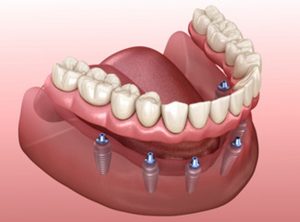
In the United States, an estimated 120 million people are missing one or more teeth. Having gaps in your beam can make you feel self-conscious and uncomfortable smiling, laughing, or speaking in front of others. Dentures are an excellent solution for those missing several or all of their teeth. Though dentures can last an average of five to seven years, they will eventually need to be relined. Keep reading to learn what to expect during this process, types of relining, and signs that your restorations need it.
What Is a Denture Reline?
When you’re missing teeth, the jawbone in that area will start to be absorbed into the body. This can cause dentures that were previously well-fitted to shift and feel unstable. A denture reline is performed to add material to the part of the denture that touches the gums. This makes the denture fit better and feel more comfortable on the gums.
3 Types of Denture Relining
There are two different kinds of denture relining, which are:
- Soft reline – This option is best for patients who need to wear dentures but can’t deal with hard material in their mouth. A soft reline is typically done when receiving dentures immediately after oral surgery. The material used for a soft reline protects the surgical site and works as a pressure bandage for those who have bone surgery during a tooth extraction but need dentures while they recover.
- Hard reline – A hard denture reline occurs approximately every two years, but the amount of time between them will be determined by you and your dentist. They are needed when the hard structure of your dentures needs to be adjusted due to jaw and gum changes. This type of reline is usually most appropriate for patients whose mouths are otherwise healthy and can withstand the hard acrylic material.
How to Know When You Need a Denture Reline
Over time, dentures will start to wear out and will eventually need to be repaired or replaced. There are several signs that you should look out for when it comes to determining when it’s time for a denture reline, such as:
- Cracks or thin lines forming in the denture
- Dentures frequently losing their grip
- Sores or irritation in your gums
- Worn chewing surfaces
- A feeling of looseness
- Visible warping
- An infection
- Worn plates
How a Denture Reline Works
The process for a soft denture reline typically takes less than an hour. Your dentist will begin by thoroughly cleaning your restorations. Next, they will remove some of the denture material where it makes contact with the gums.
Your dentist will then press a special resin applied to the denture back on the gum to make an impression. The resin will harden to create an impression that will give your dentures a tighter seal and a more comfortable fit.
For a hard denture reline, acrylic will be added to the impression to repair the base of the denture or to create a new base. You will also need a temporary restoration, and the process usually takes more than one day.
About the Practice
Windermere Dentistry cares about the oral health and overall well-being of its patients. They administer treatments like denture relining to give your restorations an upgrade and ensure that they fit your mouth properly. They can also give you tips on how to properly care for your newly relined restorations. If you are interested in making an appointment with Windermere Dentistry or want to learn more about their services, call their office at (407) 909-1099 or visit their website.
